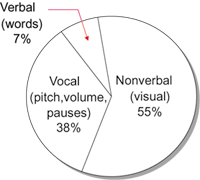SUPPORTING SKILLS
Effective Communication
Communication is essential to project team success. The project manager must communicate with team members and other stakeholders to successfully achieve project goals and to ensure that the project experience is positive.
What Is Effective Communication?
Effective communication occurs when a message is sent, received, and understood as intended. It is a two-party process, requiring willingness, motivation, and discipline on the part of both the message sender and the receiver.
Continuous feedback in necessary to check the effectiveness of the message.
Team Benefits of Effective Communication
To the project team, the benefits of communicating effectively include:
- Improved decision-making and problem solving
- Clear understanding of goals and roles
- Fewer conflicts due to erroneous assumptions and misunderstandings
- Less interpersonal friction and frustration
- Increased productivity
- Fewer surprises
- Greater satisfaction
Structure Your Message
Regardless of what or how you are communicating a message, you must structure it so that the recipient understands it.
Here are some hints for improving message effectiveness:
- Craft the message with the goal in mind.
- Draft the message, and then edit out extraneous information, unsubstantiated assumptions, and unfamiliar words or phrases.
- Front-load the message with the information of the greatest importance to the receiver.
- Provide an overview before delving into the details in long messages.
- Divide the content in long messages into smaller, more digestible amounts of information.
- Repeat key points. Repeat key points. Repeat key points.
- Close the message by summarizing or specifying the desired next step.
Nonverbal Communication
Communication consists of both verbal and nonverbal messages. The words of verbal communication constitute only a small percentage of the information. The nonverbal aspects of communication sometimes "speak" the loudest.
|
According to studies done by Albert Mehrabian at
UCLA, When all three factors – vocal, visual, and word content – are consistent your message has a better change of being received as you intended. When there is inconsistency between the factors, the listener will accept the nonverbal message as the truthful interpretation 55% of the time. |  |
© 2006 Eviton LLC